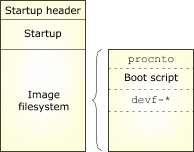The OS image is a bootable image filesystem that contains the startup header, startup code, proncto, your boot script, and any drivers needed to minimally configure the operating system:

Generally, we recommend that you keep your OS image as small as possible to realize the following benefits:
- Memory conservation — When the system boots, the entire OS image gets loaded into RAM. This image isn't unloaded from RAM, so extra programs and data built into the image require more memory than if your system loaded and unloaded them dynamically.
- Faster boot time — Loading a large OS image into RAM can take longer to boot the system, especially if the image must be loaded via a network or serial connection.
- Stability — Having a small OS image provides a more stable boot process. The fewer components you have in your OS image, the lower the probability that it fails to boot. The components that must go in your image (startup, proncto, a flash driver or network components, and a few shared objects) change rarely, so they're less subject to errors introduced during the development and maintenance cycles.
If your embedded system has a hard drive or CompactFlash (which behaves like an IDE hard drive), you can access the data on it by including a block-oriented filesystem driver (e.g. devb-eide) in your OS image filesystem and calling the driver from your boot script. For details on the driver, see devb-eide in the Utilities Reference.
If your system has an onboard flash device, you can use it to store your OS image and even boot the system directly from flash (if your board allows this — check your hardware documentation). Note that an OS image is read-only; if you want to use the flash for read/write storage, you'll need to import create a flash filesystem image (.efs file).